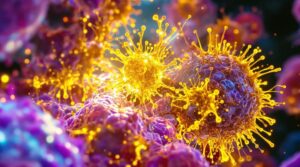
Vitamin B17, often equated with amygdalin or its derivative Laetrile, is not a true vitamin but a cyanogenic glycoside that can release cyanide, a potent toxin, when ingested. Claims of its benefits, particularly in cancer treatment, lack robust scientific support and pose serious health risks. Consultation with healthcare professionals is advised before considering its use. Understanding the full scope of amygdalin involves a critical look at both historical controversies and current research findings.
Key Takeaways
- "Vitamin B17" is not a real vitamin but a term mistakenly used for amygdalin or its synthetic form, Laetrile.
- Amygdalin can release cyanide when metabolized, posing serious health risks.
- There is no scientific evidence supporting the effectiveness of Laetrile or amygdalin in treating cancer.
- The FDA banned Laetrile in 1971 due to safety concerns and lack of proven health benefits.
- Consult healthcare professionals before using products labeled as Vitamin B17 due to potential toxicity.
The Science Behind Amygdalin and Laetrile
Amygdalin, a naturally occurring cyanogenic glycoside, and its semisynthetic derivative Laetrile, often referred to as Vitamin B17, have sparked considerable interest and debate in the scientific community.
Amygdalin metabolism involves the enzymatic cleavage into hydrogen cyanide and benzaldehyde, compounds with significant biological activity.
Laetrile synthesis, on the other hand, modifies amygdalin's structure to enhance stability and potential therapeutic efficacy. This process, mainly catalyzed in laboratory settings, aims to optimize the release of these components under controlled conditions, thereby attempting to mitigate the toxicity while harnessing potential health benefits under medical supervision.
Debunking Myths: What Vitamin B17 Is and Isn't
What exactly is Vitamin B17? It's crucial to debunk common vitamin misconceptions surrounding this term. Vitamin B17 is not a vitamin in the traditional sense but refers to compounds like amygdalin or Laetrile, which are cyanogenic compounds. These substances can release cyanide, a toxic chemical, when metabolized. Let's clarify what Vitamin B17 is and isn't through this table:
| Term | Description |
|---|---|
| Vitamin B17 | Common misnomer for amygdalin or Laetrile |
| Amygdalin | Cyanogenic glycoside found in some seeds |
| Laetrile | Synthetic derivative of amygdalin |
| Cyanide | Toxic compound released from amygdalin |
| Misconception | Incorrectly classified as a vitamin |
This table provides clarity on the often misunderstood concept of Vitamin B17.
Exploring the Health Benefits and Risks of Amygdalin

Understanding the nature and classifications of substances like amygdalin, commonly referred to as Vitamin B17, sets the stage for a deeper examination of their health implications.
Amygdalin, a cyanogenic glycoside found in certain seeds, releases cyanide upon ingestion, a mechanism that has stirred both interest and concern. Advocates suggest that, in controlled amygdalin dosages, this release can target cancer cells, though these claims lack robust clinical backing.
Conversely, health experts warn against potential toxicity, emphasizing that improper consumption of cyanogenic compounds could be lethal. Consequently, the therapeutic benefits and risks of amygdalin remain a subject of rigorous scientific scrutiny.
How to Safely Use B17 Products in Your Daily Routine
While incorporating B17 products into one's daily routine can offer perceived benefits, it is vital to approach this practice with caution due to the potential risks associated with amygdalin and its derivatives.
Here are key guidelines for safe usage:
- Consult Healthcare Providers: Always seek medical advice to determine a safe daily dosage specific to your health needs.
- Verify Product Sourcing: Purchase from reputable sources to guarantee product authenticity and safety.
- Start with Low Dosages: Gradually introduce B17 to monitor body reactions.
- Be Aware of Symptoms: Immediate consultation is essential if experiencing unusual symptoms.
The History and Evolution of Laetrile as a Treatment Option

As the medical community sought alternative cancer treatments during the mid-20th century, Laetrile emerged as a controversial option. Originating from amygdalin, its promotion was marked by both advocacy and significant skepticism. Below is a table outlining key milestones in the development and controversy of Laetrile:
| Year | Event | Impact |
|---|---|---|
| 1950 | Laetrile first used in the US | Sparked interest in alternative therapies |
| 1971 | Laetrile banned by the FDA | Increased public and legal debate |
| 1977 | Court cases challenge FDA ban | Highlighted treatment controversies |
| 1980 | Clinical trials show lack of efficacy | Cemented skepticism in medical community |
This table encapsulates the historical context and evolving debates surrounding Laetrile's use as a cancer treatment.
Frequently Asked Questions
Can Amygdalin or Laetrile Be Found in Everyday Supermarket Foods?
Amygdalin, found in seeds of certain fruits, may appear in trace amounts in supermarket foods, primarily within natural kernels. Food safety regulations oversee these products, ensuring no harmful levels are present for consumption.
Are There Any Age Restrictions for Using B17 Supplements?
Maneuvering the labyrinth of B17 supplements, age guidelines and safety concerns must be prioritized. Evidence-based practices suggest consulting healthcare providers to determine safe usage across different age groups, ensuring cautious and informed application.
How Do Different Countries Regulate the Sale of Laetrile?
Different countries exhibit varied stances on Laetrile due to international regulations and bans, reflecting diverse legal frameworks and health policy considerations. This disparity underscores the complexity of its global legal status.
What Are Common Misconceptions About the Taste of Amygdalin-Containing Foods?
Ironically, despite its perilous content, amygdalin-containing foods often have an appealingly sweet initial taste. Misconceptions arise when flavor profiles are assumed benign; however, taste perception does not correlate with potential toxicity.
Are There Environmental Impacts From Cultivating Amygdalin-Rich Crops?
Cultivating amygdalin-rich crops can impact the environment, potentially affecting sustainable agriculture practices and crop diversity. However, evidence on specific environmental consequences remains limited, necessitating cautious evaluation and research in these agricultural practices.
Conclusion
In summary, while the allure of amygdalin, or "Vitamin B17," as a natural cancer treatment captivates many, the evidence remains inconclusive. Scientific scrutiny has both confirmed the risks and questioned the benefits. Consequently, individuals considering B17 products must proceed with caution, prioritize evidence-based guidance, and consult healthcare professionals. As research continues, our understanding may evolve, but for now, the balance of safety and efficacy must guide our choices in the domain of health interventions.




